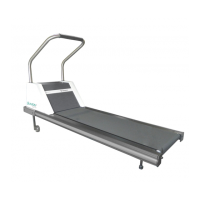Cardiac Stress Treadmills Service Manual Troubleshooting 3-3
Electronic Problems
Error Codes
Error codes provide the first means of treadmill diagnostics. The treadmill
performs an electronic self-test each time that it is powered up. If a
problem is detected during either power-up or operation, an error code
appears on the stress monitor. Note the code recorded by the owner and
reference the table of error codes in the service manual for your stress
monitor.
If you replace a faulty PCB Assembly, return it to the factory and note the
error code.
Mechanical Problems
Mechanical problems can include noise and vibration caused by loose or
worn parts. Use the following tables to diagnose mechanical failures.
Walking belt
Drive Belt
Treadmill Noise
The following table provides a diagnostic summary of bearing noises,
along with other noises that may indicate problems.
Problem Action
Walking belt slipping. Adjust walking belt tension
(see “Belt Tension” on page 4-23).
Walking belt not tracking. Adjust tracking
(see “Walking Belt Tracking” on page 4-24).
Walking belt worn out. Replace walking belt
(see “Replacing the Walking Belt” on page 4-22).
Symptom Possible Cause Action
Squealing sound similar to
automobile fan belt.
Walking belt slows when
user’s foot strikes the deck.
Drive motor belt (poly-V
drive belt) is slipping.
Adjust belt tension or
replace belt.
Belt stops and an over-
current error code appears.
Stopping the belt for more
than 2 seconds when the
belt is set to ON can cause
an over-current shutdown.
1. Don’t stop belt longer
than 2 seconds.
2. Replace the deck and
belt.
Noise Possible Cause Action
Knocking* or thumping.
Rate increases and
decreases with walking belt
speed.
Front or rear roller (pulley)
assembly bearings.
Isolate** and replace roller.

